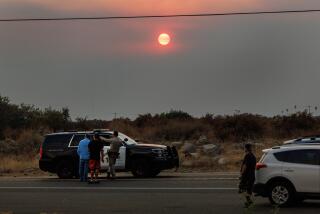Southland Agency Mismanaged Smog Credit Program, Suit Alleges
Air quality officials are mismanaging one of Southern California’s key anti-smog programs, resulting in excessive emissions that contribute to smog, two environmental groups charge in a lawsuit.
The lawsuit, which was filed Monday in U.S. District Court in Los Angeles, targets a landmark program launched 10 years ago as a flexible way to cut emissions from about 350 facilities, including power plants and factories. Named the Regional Clean Air Incentives Market, the plan allows companies to buy and sell pollution credits to reduce emissions at less cost with less government red tape.
But the lawsuit alleges lax oversight of the program by the South Coast Air Quality Management District. Specifically, the lawsuit alleges, shoddy record-keeping and a failure to carefully monitor the exchange of pollution credits have compromised the program.
As much as 1 million pounds of excess smog-forming gases have been released to the environment as a result, said Scott Kuhn, attorney for Oakland-based Communities for a Better Environment.
“The air district is allowing companies to manipulate the pollution trading rules, thereby increasing smog,” Kuhn said.
The allegation comes at a sensitive time in the war on smog, after Los Angeles has suffered through its worst summer ozone season in six years. There have been 63 days when ozone, the main ingredient in smog, reached unhealthful levels this year. In July, for the first time in five years, a local community, Lake Arrowhead, experienced a first-stage ozone alert, which signified that smog was very unhealthful for all residents.
“The South Coast air basin is one of the dirtiest places in the country,” said Tiffany Schauer, executive director of Our Children’s Earth, a San Francisco-based environmental group and a plaintiff in the lawsuit. “The air district, which is supposed to be in charge of cleaning it up, is instead turning a blind eye on the problem and allowing big polluters to game the system.”
Specifically, the lawsuit alleges that the AQMD has been neglecting a requirement in the program’s regulations that requires polluters to reconcile their actual emissions and pollution credits in a timely manner.
Under the program, a company that reduces more emissions than required can earn credits representing the extra emissions. Those credits can be banked and reused in the future, sold on the open market at a profit or sold to another company that emitted more than its allocated amount.
The AQMD must monitor the trades and ensure that the quantities of emissions and credits match.
But, Kuhn said, the air district failed to do this properly. The regulation requires a quarterly reconciliation of pollution-trading accounts; Kuhn said the air district waited until the end of the year to reconcile accounts. The delay allowed companies to release extra emissions throughout the year, he said.
In addition, the lawsuit alleges that shoddy record-keeping makes it almost impossible to keep track of the pollution trades and to determine which companies are in compliance and which are not.
The environmental groups allege that the problems in the program occurred between 1998-2002, resulting in the release of an additional 926,878 pounds of nitrogen oxide gas, a precursor to ozone and haze.
“It’s really impossible to tell how this program is working. It’s like a maze, trying to sort through all the pollution trades. It’s not working as it was originally planned,” Kuhn said.
Officials at the South Coast Air Quality Management District could not be reached for comment.
The program was launched in 1993 with the aim of cutting 13,000 tons of emissions, a 70% reduction, from major businesses, oil refineries and power plants.
It was the nation’s first market-based program aimed at reducing urban air pollution. Among the companies participating in the market are Walt Disney Corp., Northrop Grumman Corp. and Exxon Mobil Corp.
More to Read
Sign up for Essential California
The most important California stories and recommendations in your inbox every morning.
You may occasionally receive promotional content from the Los Angeles Times.









